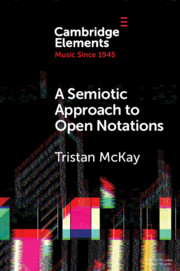Bibliography
Asher, Leah, “Home Page.” Leah Asher official website. Accessed December 17, 2019. www.leahasher.com. Asher, Leah, TRAPPIST-1 (Independently published, 2017).
Brent, Joseph, Charles Sanders Peirce: A Life (Bloomington: Indiana University Press, 1993).
Brown, Earle, FOLIO (1952/53) and 4 Systems (1954) (New York: Associated Music, 1961).
Brown, Earle, “The Notation and Performance of New Music,” Musical Quarterly 72, no.2 (1986), 180–201.
Brown, Earle, “On December 1952,” [1970; transcription of audio] American Music 26, no. 1 (Spring 2008), 1–12.
Brown, Earle, “Prefatory Note,” in FOLIO (1952/53) and 4 Systems (1954) (New York: Associated Music, 1961).
Cady, Jason, “An Overview of Earle Brown’s Techniques and Media,” in Beyond Notation: The Music of Earle Brown, edited by Kim, Rebecca Y. (Ann Arbor: University of Michigan Press, 2017), 1–20.
Cage, John, Notations, edited by Knowles, Alison and Cage, John (New York: Something Else Press, 1969).
Chandler, Daniel, Semiotics: The Basics, 2nd edition (London: Routledge, 2002).
Chumley, Lily, and Harkness, Nicholas, “Introduction: QUALIA,” Anthropological Theory 13, no. 1–2 (2013), 3–11.
Cowell, Henry, “Explanation of Symbols and Playing Instructions,” in Piano Music by Henry Cowell (New York: Associated Music, 1960).
Eco, Umberto, The Open Work, translated by Anna Cancogni (Cambridge, MA: Harvard University Press, 1989).
Goehr, Lydia, “Being True to the Work,” Journal of Aesthetics and Art Criticism 47, no.1 (Winter 1989), 55–67.
Goehr, Lydia, The Imaginary Museum of Musical Works, revised edition (London: Oxford University Press, 2007).
Goodman, Nelson, Languages of Art [1968], new edition (Indianapolis, IN: Hackett, 1976).
Gresser, Clemens, “Earle Brown’s ‘Creative Ambiguity’ and Ideas of Co-creatorship in Selected Works,” Contemporary Music Review 26, no. 3/4 (June/August 2007), 377–394.
Harkness, Nicholas, “Softer Soju in South Korea,” Anthropological Theory 13, no. 1–2 (2013), 12–30.
Harkness, Nicholas, Songs of Seoul: An Ethnography of Voice and Voicing in Christian South Korea (Berkeley: University of California Press, 2014).
Hoover, Elizabeth, “Collage and the Feedback Condition of Earle Brown’s Calder Piece,” in Beyond Notation: The Music of Earle Brown, edited by Kim, Rebecca Y. (Ann Arbor: University of Michigan Press, 2017), 159–187.
Jakobson, Roman, “Closing Statement: Linguistics and Poetics,” in Style in Language, edited by Sebeok, Thomas A. (Cambridge: MIT Press, 1960), 350–377.
Kanno, Mieko, “Prescriptive Notation: Limits and Challenges,” Contemporary Music Review 26, no. 2 (2007), 231–254.
Karkoschka, Erhard, Notation in New Music: A Critical Guide to Interpretation and Realization, translated by Ruth Koenig (New York: Praeger, 1972).
Kulvicki, John, “Analog Representation and the Parts Principle,” Review of Philosophy and Psychology 6 (2015), 165–180.
Lévi-Strauss, Claude, Structural Anthropology, translated by Claire Jacobson and Brooke Grundfest Schoepf (New York: Basic Books, 1963).
Mavromatis, Panayotis, “A Multi-tiered Approach for Analyzing Expressive Timing in Musical Performance,” in Mathematics and Computation in Music, edited by Chew, Elaine, Childs, Adrian, and Chuan, Ching-Hua (Berlin: Springer, 2009), 193–204.
McKay, Tristan, “Graphic Notations As Creative Resilience in Redman’s Book (2006),” in Semiotics 2018: Resilience in an Age of Relation, edited by Owens, Geoffrey Ross and Katić, Elvira (Charlottesville, VA: Philosophy Documentation Center Press, 2019), 157–171.
Merrell, Floyd, “Charles Sanders Peirce’s Concept of the Sign,” in The Routledge Companion to Semiotics and Linguistics, edited by Cobley, Paul (London: Routledge, 2001), 28–39.
Mitchell, W. J. T, “Pictures and Paragraphs: Nelson Goodman,” in Iconology: Image, Text, Ideology (Chicago: University of Chicago Press, 1986), 47–74.
Munn, Nancy D, The Fame of Gawa: A Symbolic Study of Value Transformation in a Massim (Papua New Guinea) Society (Cambridge: Cambridge University Press, 1986).
Nonken, Marilyn, The Spectral Piano: From Liszt, Scriabin, and Debussy to the Digital Age (Cambridge: Cambridge University Press, 2014).
Parmentier, Richard, Signs in Society: Studies in Semiotic Anthropology (Indianapolis: Indiana University Press, 1994).
Peirce, Charles S., Hartshorne, Charles, Weiss, Paul, and Burks, Arthur W., Collected Papers of Charles Sanders Peirce (Cambridge, MA: Belknap Press of Harvard University Press, 1965).
Redman, Will, “Honoring Vertical Excellence,” Will Redman official website (2011). Accessed December 17, 2019. www.willredman.com/hve.html Redman, Will, “Will Redman: Graphic Ideas in Sound,” video interview by Molly Sheridan, New Music Box (blog) (July 27, 2011). Accessed December 17, 2019. https://vimeo.com/26929349 Robey, David, Introduction to The Open Work, by Umberto Eco (Cambridge, MA: Harvard University Press, 1989), vii–xxxii.
Ruwet, Nicholas, and Everist, Mark, “Methods of Analysis in Musicology,” Music Analysis 6, no. 1/2 (March–July 1987), 3–9, 11–36.
Sauer, Theresa, Notations 21 (New York: Mark Batty, 2009).
de Saussure, Ferdinand, Course in General Linguistics [1916], new edition translated by Roy Harris (La Salle, IL: Open Court, 1986).
Tormey, Alan, “Indeterminacy and Identity in Art,” The Monist 58, no. 2 (April 1974), 203–215.
Tufte, Edward R., The Visual Display of Quantitative Information, (Cheshire, CT: Graphics Press, 1983).
Tullett, Barrie, Typewriter Art: A Modern Anthology (London: Laurence King, 2014).
Urban, Greg, “Entextualization, Replication, and Power,” in Natural Histories of Discourse, edited by Silverstein, Michael and Urban, Greg (Chicago: University of Chicago Press, 1996), 21–44.
Waugh, Linda, “The Poetic Function in the Theory of Roman Jakobson,” Poetics Today 2, no. 1a (Autumn 1980), 57–82.

 Loading metrics...
Loading metrics...


